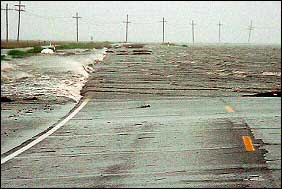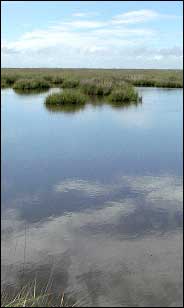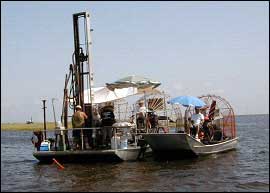















Successes in Stewardship: January 2004 |
|---|

|
Federal Highway Administration
January 2004
Protecting Invaluable Wetlands While Improving Safety and Mobility: Louisiana Highway 1

As the only land route connecting the Gulf communities of Port Fourchon and Grand Isle (located on Louisiana's only inhabited barrier island) with the rest of the state, Louisiana Highway 1 (LA 1) is both the area's primary hurricane evacuation route and an important energy link for the nation. The two-lane road services Port Fourchon, which accommodates 26% of domestic natural gas shipments, 17% of domestic oil shipments, and foreign oil offloaded from ships in the Gulf of Mexico. Local commercial and recreational fish industries also use the highway. It's no wonder that Congress designated LA 1 as a "high priority corridor," recognizing its national importance.
This vital connector, which crosses ecologically unique and sensitive wetlands, is susceptible to severe flooding; some areas risk washout during storms. Accordingly, the Louisiana Department of Transportation (LADOTD) and the Federal Highway Administration — Louisiana Division (FHWA-LA) are building a four-lane, 17-mile, elevated highway to improve safety and mobility for local residents, workers, and associated industries. Mindful that the area's scenic, aesthetic, historic, and environmental resources must be preserved, the agencies employed a context-sensitive approach, embracing the use of innovative technologies, operating procedures, and collaborative decision-making strategies.
 |
The LA 1 project employed innovative planning strategies and construction techniques to protect coastal wetlands. Photo Credit: LADOTD |
Louisiana has the highest rate of coastal wetlands loss of any state; over the last 70 years, it has lost more than 1,500 square miles of marsh, an area approximately the size of Rhode Island. Lafourche Parish, where the elevated highway will be constructed, has the second highest rate of coastal erosion of Louisiana's 14 parishes. Highly motivated to preserve Louisiana's invaluable wetlands, transportation professionals were determined to apply planning, site evaluation, and construction approaches that acknowledge the unique and fragile marsh setting. Their most notable context-sensitive streamlining efforts apply collaborative decision-making and new technologies to the process.
The LA 1 project moved efficiently through the NEPA process on an expedited schedule. The Record of Decision was signed in just under four years, nearly half the normal time associated with projects of equal magnitude and in such environmentally sensitive locations. Transportation professionals in LADOTD and FHWA-LA attribute much of this success to open communication and cooperation among stakeholders. Beginning early in the planning process regular meetings involved all agencies in discussing each group's needs, implementation approaches, and permitting obligations. By developing cooperative "partnerships," Federal and state resource agencies, along with private consulting and engineering firms, created a team atmosphere. Collaborative decision-making helped to ensure active and full participation among agencies and constituents, and enabled the team to meet transportation needs while avoiding detrimental environmental impacts.
 |
To avoid damage to wetlands, an oversized airboat was chosen to carry the cone penetrometer during soil investigations. Photo Credit: LADOTD |
Not so long ago, the complex environmental issues raised by the LA 1 enterprise might have stopped the project cold. Fortunately, new, environmentally responsible technologies and operating procedures were available. In choosing these innovative tools to preserve Louisiana's coastal marshland, LADOTD was able to minimize impacts to the resources.
The airboat technology and end-on construction methods were not the least expensive routes available to LADOTD and FHWA-LA. Nevertheless, the two Administrations, through careful collaboration with other public and private agencies, decided that cost-intensive methods used up front would considerably reduce project development time and least damage the area's irreplaceable marsh resources, resulting in long-term savings on mitigation costs.
Lessons Learned
|
Although LA 1's location-specific issues are not the norm, transportation professionals can gain valuable insight from the project's holistic approach. From the outset, all involved agencies agreed to regular and ongoing communication, and ultimately decided to use planning strategies and construction techniques suited to the project's unique context. LADOTD, FHWA-LA, and other project stakeholders developed a common vision and worked creatively to mitigate further coastal erosion and marsh destruction. With preliminary construction to begin in early-to-mid 2004, they look forward to an environmentally responsible transportation investment that enhances the public's safety and mobility, the region's economy, and the nation's energy resources.
Contact InformationMichele Deshotels, LADOTDP.O. Box 94245 Baton Rouge, LA 70804-9245 (225) 242-4506 MicheleDeshotels@dotd.louisiana.gov David Miller, LADOTD P.O. Box 94245 Baton Rouge, LA 70804-9245 (225) 379-1309 DavidMiller@dotd.louisiana.gov |
|
"Successes in Stewardship" is a Federal Highway Administration newsletter highlighting current environmental streamlining practices from around the country. To subscribe, call (617) 494-6352 or email esnewsletter@volpe.dot.gov. |
